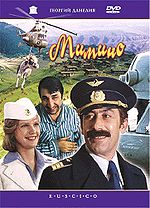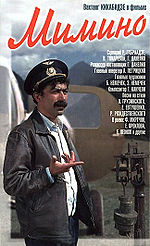
Mimino
Encyclopedia
Mimino , is a 1977 comedy film by Soviet Georgian director Georgi Daneliya
produced by Mosfilm
and Gruziya-film
, starring Vakhtang Kikabidze
and Frunzik Mkrtchyan. Anatoliy Petritskiy served as the film's Director of Photography. The Soviet era
comedy won the 1977 Golden Prize at the Moscow International Film Festival. It is also highly rated by users of the Internet Movie Database, with 88% of 1,042 users giving it an 8 or better as of February 2010.
bush pilot
Mimino (Vakhtang Kikabidze
) works at small local airlines, flying helicopters between small villages. But he dreams of piloting large international airlines aircraft, so he decides to go to Moscow
to follow his dream. There in a hotel he meets Armenian
truck driver Roobik Khachikyan (Frunzik Mkrtchyan) who is given a place in that hotel by mistake instead of another Khachikyan (Professor), and they have a lot of adventures in Moscow.

 Always amicable and open to people, Mimino does not feel at home in the big city. Nevertheless, he becomes a pilot of a supersonic jet liner, the Tupolev Tu-144
Always amicable and open to people, Mimino does not feel at home in the big city. Nevertheless, he becomes a pilot of a supersonic jet liner, the Tupolev Tu-144
, flying all over the world. But feeling homesick, he finally comes back to his native town of Telavi
in Georgia, to his family and friends.
Mimino's real name in the film is Valentin Mizandari - his nickname 'Mimino' is the Georgian word for sparrow hawk, although it is stated on the back cover of the DVD that 'Mimino' means falcon
. Either way, it seems that this nickname is to equate to some kind of bird of prey, which is perhaps fitting for a pilot.
1978 - "Golden Lacheno" Award at the 19th IFF in Avellino (Italy)
1978 - Best Comedy Film Award at the 11th All-Union Film Festival in Yerevan
1978 - USSR State Prize (Director G. Daneliya, Actors V. Kikabidze, F. Mkrtchyan)
{1}
Georgi Daneliya
Georgi Daneliya is a Soviet/Georgian/Russian film director, who became known throughout the Soviet Union for his "sad comedies" .Daneliya graduated from the Moscow Architecture Institute and worked as an architect...
produced by Mosfilm
Mosfilm
Mosfilm is a film studio, which is often described as the largest and oldest in Russia and in Europe. Its output includes most of the more widely-acclaimed Soviet films, ranging from works by Tarkovsky and Eisenstein , to Red Westerns, to the Akira Kurosawa co-production and the epic Война и Мир...
and Gruziya-film
Gruziya-film
Kartuli Pilmi was a Soviet film studio in Tbilisi in the former Georgian Soviet Socialist Republic. Kartuli Pilmi was founded in 1921 as a film section of the Commissariat of Education. In 1923 the film section was reorganized into a trust under the name Georgian State Film Industry...
, starring Vakhtang Kikabidze
Vakhtang Kikabidze
Vakhtang "Buba" Kikabidze is a Georgian and Soviet singer, actor, screenwriter, producer, and composer. He performed in a number of films, among them the main role of a helicopter pilot in the iconic Soviet film Mimino....
and Frunzik Mkrtchyan. Anatoliy Petritskiy served as the film's Director of Photography. The Soviet era
Soviet Union
The Soviet Union , officially the Union of Soviet Socialist Republics , was a constitutionally socialist state that existed in Eurasia between 1922 and 1991....
comedy won the 1977 Golden Prize at the Moscow International Film Festival. It is also highly rated by users of the Internet Movie Database, with 88% of 1,042 users giving it an 8 or better as of February 2010.
Plot
GeorgianGeorgians
The Georgians are an ethnic group that have originated in Georgia, where they constitute a majority of the population. Large Georgian communities are also present throughout Russia, European Union, United States, and South America....
bush pilot
Bush flying
Bush flying is a term for aircraft operations carried out in remote, inhospitable regions of the world. Bush flying involves operations in rough terrain where there are often no prepared landing strips or runways, frequently necessitating that bush planes be equipped with abnormally large tires,...
Mimino (Vakhtang Kikabidze
Vakhtang Kikabidze
Vakhtang "Buba" Kikabidze is a Georgian and Soviet singer, actor, screenwriter, producer, and composer. He performed in a number of films, among them the main role of a helicopter pilot in the iconic Soviet film Mimino....
) works at small local airlines, flying helicopters between small villages. But he dreams of piloting large international airlines aircraft, so he decides to go to Moscow
Moscow
Moscow is the capital, the most populous city, and the most populous federal subject of Russia. The city is a major political, economic, cultural, scientific, religious, financial, educational, and transportation centre of Russia and the continent...
to follow his dream. There in a hotel he meets Armenian
Armenians
Armenian people or Armenians are a nation and ethnic group native to the Armenian Highland.The largest concentration is in Armenia having a nearly-homogeneous population with 97.9% or 3,145,354 being ethnic Armenian....
truck driver Roobik Khachikyan (Frunzik Mkrtchyan) who is given a place in that hotel by mistake instead of another Khachikyan (Professor), and they have a lot of adventures in Moscow.


Tupolev Tu-144
The Tupolev Tu-144 was a Soviet supersonic transport aircraft and remains one of only two SSTs to enter commercial service, the other being the Concorde...
, flying all over the world. But feeling homesick, he finally comes back to his native town of Telavi
Telavi
Telavi is the main city and administrative center of Georgia's eastern province of Kakheti. Its population consists of some 21,800 inhabitants . The city is located on foot-hills of Tsiv-Gombori Range at 500-800 meters above the sea level....
in Georgia, to his family and friends.
Mimino's real name in the film is Valentin Mizandari - his nickname 'Mimino' is the Georgian word for sparrow hawk, although it is stated on the back cover of the DVD that 'Mimino' means falcon
Falcon
A falcon is any species of raptor in the genus Falco. The genus contains 37 species, widely distributed throughout Europe, Asia, and North America....
. Either way, it seems that this nickname is to equate to some kind of bird of prey, which is perhaps fitting for a pilot.
DVD Extras
The film's cinematographer, Anatoliy Petritskiy, is interviewed about the film. He reminisces about his experiences working with Daneliya and the actors. He had known Daneliya for some time and had seen several of his films. He was very happy to receive the offer to work with him. Initially the two were working on a different film in 1977, and discussed the doubts they had about the script, after which they decided to work on "Mimino" as an alternative. Petritskiy was surprised that Goskino had already approved the film and that funding had been secured, and the project moved forward. Petritskiy discusses the locations of the various shots in the film, to include various villages in Georgia, the Tbilisi airport, Moscow, and what was then West Germany. According to Petritskiy, casting the film was not a problem, as Daneliya was familiar with all of the actors in the film. More strange to the cinematographer, was Daneliya's wish to shoot scenes in the mountainous region Tushetia, because it is was a very remote area that could only be reached by helicopter, rather than roads. Petritskiy described the conditions as "medieval". He noted that the lack of electricity had "put its stamp of the character of the population of Amalo", which basically lived without light. He described the society as "patriarchic". He describes this as the conflict in the film--the conflict between the simple way of life and the way of life in the big city -- the is the meaning of the film as he sees it. It is because of this that he filmed the movie in a very simple style, "a restrained style". He points out that even the portions of the film shot in Moscow are static shots or simple panoramas. He considers the landscapes of Georgia in the film to be "extremely beautiful". Petritskiy then discusses the various shots at airports, which were done as a montage - the helicopter in Tbilisi, and the magnificent TU plane shot in Moscow. Initially the latter part of the film was to be shot in America, but because of "purely budgetary reasons" according to Petritskiy, the cast and crew could not film there, so opted to shoot in West Berlin. Thus, the script was revised. Petritskiy notes that the Soviets were in power during 1977, so it was arranged that the group would stay in East Berlin--again "for economic reasons", and every day had to cross the border to the American zone to film at the Tegel Airport. As for the scenes with the cow (hanging from the helicopter), it was shot in two stages--a papier-mache dummy of a cow was used with the helicopter for the far off shots, and a live cow was lifted by a crane was used for the close-ups. He notes that the cow was only hung at a low height, but high enough to use the blue sky as a backdrop, and the cow was not hurt. Petritskiy did not consider the scene to be difficult, pointing out that the winter scenes were much harder. He details the harsh living conditions in the village of Darklo where they stayed. He describes how few locals stay during the winter, and how the living quarters were not guarded or locked, but housed a few shepherds who had stayed back for the winter. He explains how there were "sleep-benches" within the houses, and how they lived on canned preserves during their stay, sharing their "feast" with the hungry shepherds there. In conclusion, Petritskiy notes how he "got a very pleasant impression from the work on that film," noting that it was shown at the Moscow International Film Festival and won the top prize there.{1}Awards
1977 - Golden Prize at the 10th Moscow International Film Festival1978 - "Golden Lacheno" Award at the 19th IFF in Avellino (Italy)
1978 - Best Comedy Film Award at the 11th All-Union Film Festival in Yerevan
1978 - USSR State Prize (Director G. Daneliya, Actors V. Kikabidze, F. Mkrtchyan)
{1}

